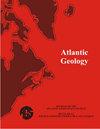Protracted intra- and inter-pluton magmatism during the Acadian orogeny: evidence from new LA-ICP-MS U-Pb zircon ages from northwestern Maine, USA
IF 0.9
4区 地球科学
Q2 GEOLOGY
引用次数: 4
Abstract
Devonian granitoid plutons comprise a major part of the bedrock of northwestern Maine representing the magmatic expression of the Acadian orogeny in this part of the northern Appalachian orogen. They are petrographically diverse with minerals characteristic of both I- and S-type granites, in some cases within the same intrusion, and some are compositionally zoned. New LA-ICP-MS ages presented here elucidate the timing and duration of this magmatism. The earliest phase of granitoid magmatism began around 410–405 Ma with the emplacement of the Flagstaff Lake Igneous Complex, and the presence of contemporaneous mafic rocks suggests that mantle-derived magmas were also produced at this time. Late Devonian ages, ca. 365 Ma, for many intrusions, such as the Chain of Ponds and Songo plutons, reveal that magmatism continued for 45 million years during which compositionally diverse I- and S-type magmas were produced. In addition, there is evidence that intrusive activity was prolonged within some plutons, for example the Rome-Norridgewock pluton and the Mooselookmeguntic Igneous Complex, with 10–15 myr between intrusive units. The new ages suggest a break in magmatism between 400 Ma and 390 Ma apparently separating Acadian magmatism into early and late pulses. The production of lower crustal I-type magmas appears to have been concentrated later, ca. 380–365 Ma, although several S-type granitoids were also emplaced during this period. These Late Devonian plutons display abundant zircon inheritance with ages around 385 Ma, which suggests that the crust was experiencing enhanced thermal perturbations during this extended timeframe. The new data for granitoid plutons in northwestern Maine are consistent with tectonic models for other parts of Ganderia which propose initial flat slab subduction followed by slab breakoff and delamination.阿卡迪亚造山运动期间持续的岩浆作用:来自美国缅因州西北部新LA-ICP-MS U-Pb锆石的证据
泥盆纪花岗岩类深成岩体构成缅因州西北部基岩的主要部分,代表了阿巴拉契亚造山带北部阿卡迪亚造山带的岩浆表现。它们在岩相学上多种多样,具有I型和S型花岗岩的矿物特征,在某些情况下位于同一侵入体内,有些则在成分上被划分。这里提出的新的LA-ICP-MS年龄阐明了这种岩浆作用的时间和持续时间。花岗岩类岩浆作用的最早阶段始于410–405 Ma左右,弗拉格斯塔夫湖火成岩杂岩侵位,同期镁铁质岩石的存在表明,地幔衍生的岩浆也在此时产生。晚泥盆纪,约365 Ma,许多侵入体,如池塘链和松戈深成岩体,表明岩浆作用持续了4500万年,在此期间产生了成分多样的I型和S型岩浆。此外,有证据表明,一些深成岩体中的侵入活动延长,例如罗马-诺里奇沃克深成岩体和穆塞洛克梅古提克火成岩杂岩,侵入单元之间的侵入活动时间为10-15 myr。新的时代表明400 Ma至390 Ma之间的岩浆作用断裂,显然将阿卡迪亚岩浆作用分为早期和晚期脉冲。下地壳I型岩浆的产生似乎集中在晚些时候,约380–365 Ma,尽管在这一时期也侵位了一些S型花岗岩。这些晚泥盆纪深成岩体显示出丰富的锆石继承性,年龄约为385 Ma,这表明地壳在这一延长的时间段内经历了增强的热扰动。缅因州西北部花岗岩类深成岩体的新数据与Ganderia其他地区的构造模型一致,该模型提出了最初的平板俯冲,然后是板块断裂和分层。
本文章由计算机程序翻译,如有差异,请以英文原文为准。
求助全文
约1分钟内获得全文
求助全文
来源期刊

Atlantic Geology
GEOLOGY-
CiteScore
2.10
自引率
18.80%
发文量
0
审稿时长
>12 weeks
期刊介绍:
Atlantic Geology (originally Maritime Sediments, subsequently Maritime Sediments and Atlantic Geology) covers all aspects of the geology of the North Atlantic region. It publishes papers, notes, and discussions on original research and review papers, where appropriate to the regional geology.
 求助内容:
求助内容: 应助结果提醒方式:
应助结果提醒方式:


